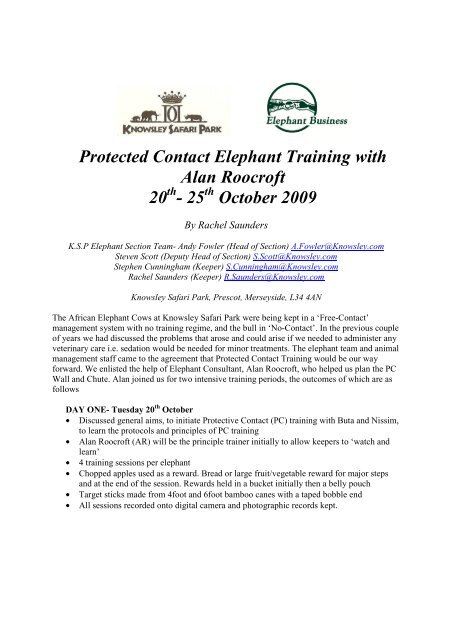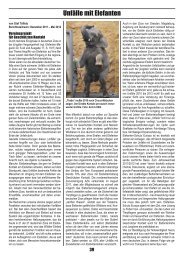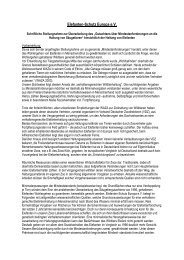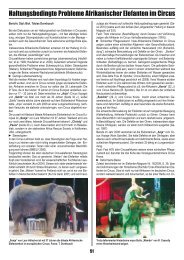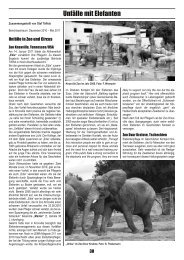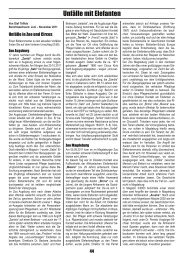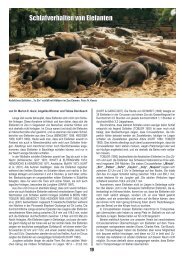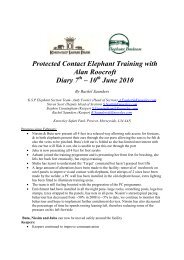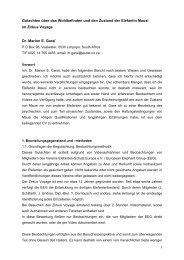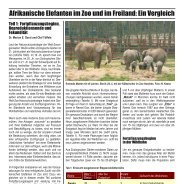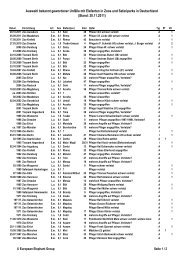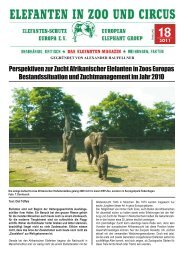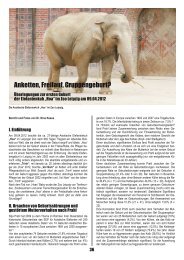You also want an ePaper? Increase the reach of your titles
YUMPU automatically turns print PDFs into web optimized ePapers that Google loves.
Protected Contact Elephant Training with<br />
Alan Roocroft<br />
20 th - 25 th October 2009<br />
By <strong>Rachel</strong> <strong>Saunders</strong><br />
K.S.P Elephant Section Team- Andy Fowler (Head of Section) A.Fowler@Knowsley.com<br />
Steven Scott (Deputy Head of Section) S.Scott@Knowsley.com<br />
Stephen Cunningham (Keeper) S.Cunningham@Knowsley.com<br />
<strong>Rachel</strong> <strong>Saunders</strong> (Keeper) R.<strong>Saunders</strong>@Knowsley.com<br />
Knowsley Safari Park, Prescot, Merseyside, L34 4AN<br />
The African Elephant Cows at Knowsley Safari Park were being kept in a ‘Free-Contact’<br />
management system with no training regime, and the bull in ‘No-Contact’. In the previous couple<br />
of years we had discussed the problems that arose and could arise if we needed to administer any<br />
veterinary care i.e. sedation would be needed for minor treatments. The elephant team and animal<br />
management staff came to the agreement that Protected Contact Training would be our way<br />
forward. We enlisted the help of Elephant Consultant, Alan Roocroft, who helped us plan the PC<br />
Wall and Chute. Alan joined us for two intensive training periods, the outcomes of which are as<br />
follows<br />
DAY ONE- Tuesday 20 th October<br />
• Discussed general aims, to initiate Protective Contact (PC) training with Buta and Nissim,<br />
to learn the protocols and principles of PC training<br />
• Alan Roocroft (AR) will be the principle trainer initially to allow keepers to ‘watch and<br />
learn’<br />
• 4 training sessions per elephant<br />
• Chopped apples used as a reward. Bread or large fruit/vegetable reward for major steps<br />
and at the end of the session. Rewards held in a bucket initially then a belly pouch<br />
• Target sticks made from 4foot and 6foot bamboo canes with a taped bobble end<br />
• All sessions recorded onto digital camera and photographic records kept.
Figure 1: Reward food items<br />
Figure 2: Video Camera<br />
NISSIM<br />
• The first and second sessions were spent walking Nissim from one end of the PC wall to<br />
the other. When Nissim responded to the command ‘Nissim Come’, he was rewarded and<br />
praised.<br />
• Nissim was calm and came close-up to the PC wall with his head and responded well in a<br />
focused way.<br />
• Whilst moving Nissim around the facility, he was held at stations to allow safe<br />
opening/closing of gates. He rushed a few of the gates so this behaviour will not be<br />
encouraged<br />
• Between the 1 st and 2 nd sessions Nissim was moved into his night pen and Buta brought<br />
into the PC pen. Between the 2 nd -4 th sessions Nissim was held in the bull yard and finally<br />
released into the paddock with the herd.<br />
• Short sessions were held at Gate 2 (see gate plan Appendix 1) and also at Gate 3 to see if<br />
a more positive response was obtained.<br />
• In the 3 rd and 4 th sessions the target stick was introduced, but Nissim was not keen on this<br />
at all and flung his trunk at it. He became impatient, lost attention and began pacing, as if<br />
he had a phobia of the target. Without the target he performed again.<br />
BUTA<br />
• Buta showed high levels of aggression, charging the bars, hurtling about screaming and<br />
rushing the gates, she is not used to being separated from the herd<br />
• Both elephants seemed to dislike the area of the PC wall where vision is blocked by heavy<br />
steelwork i.e. the keeper gate and by Gate 4- hopefully in time they will get used to this<br />
• As each session progressed Buta calmed down and did not hurtle about or scream<br />
• 1 st session- Buta responded to command ‘Buta Come’ and was rewarded and praised,<br />
even when she showed aggression on approach<br />
• 2 nd session- Introduction of the target stick. She learnt quickly to come in close and touch<br />
the target onto her head. Any unwanted behaviours including bashing the target or lifting<br />
her trunk were not reinforced.<br />
• 3 rd and 4 th sessions were shorter, just reinforcing learnt behaviours. Buta wanted to return<br />
quickly to the herd<br />
Conclusions-<br />
• Overcoming Nissim’s phobia is key to progression<br />
• Alan stated aggressive bulls are easier to train
• Buta was trained in free contact many years ago, so may be remembering some of the<br />
commands, whereas Nissim has never bee trained before<br />
• ‘Wild herd’ difficult to hold by Gate 15. Alan advised us not to lob food to the<br />
elephants, but to throw it in a line by the fence and call the elephants, allowing them<br />
to come in an order they are comfortable with<br />
DAY 2- Wednesday 21 st October<br />
NISSIM<br />
• 4 training sessions<br />
• Continued trying to introduce target to Nissim, but he only let it touch his head a couple<br />
of times<br />
• Nissim followed up and down the PC wall on command<br />
• During the final session he responded to ‘Trunk Up’ and allowed the target to briefly<br />
touch the underside of his trunk<br />
BUTA<br />
• 4 training sessions, each short and sharp to reinforce good learnt behaviours<br />
• Buta showed slight aggression a.m but no screaming or charging, and she settled quickly<br />
into the routine of coming to target along the PC wall.<br />
• Foot target introduced, she was slightly curious about the target but quite comfortable<br />
with it touching her foot<br />
Conclusions-<br />
• Sessions becoming shorter in duration<br />
• Attention spans of the elephants need to be considered<br />
• Nissim progressing slowly and warming to the target, Alan aims to overcome Nissim’s<br />
phobia of the target to be conquered by desensitizing the underside of his trunk and<br />
gradually moving it round to the top of his head i.e. building trust<br />
• Buta has calmed down immensely, is learning quickly, and is so keen that she does not<br />
want to go back out<br />
• Keepers more confident with gate procedures and general protocol of training,<br />
communication is key<br />
DAY 3- Thursday 22 nd October<br />
• 3 sessions per elephant due to realistic aims i.e. staffing levels, time available and<br />
elephant attention spans<br />
• Peter Litchfield and Jen Quayle (Vet, Rose Cottage Veterinary Surgery) observed a<br />
session. Jen keen to observe more to see how this will benefit healthcare of the elephants<br />
• Opened Gate 12 so Buta returns to the herd more readily after sessions due to a more<br />
direct route<br />
• Opened Gate 15 so cows can be fed further away when Buta is brought in for training and<br />
out onto the yard<br />
NISSIM<br />
• Shorter sessions today
• Focused on ‘Trunk Up’ command. Nissim allowed the target to be rubbed on his trunk.<br />
Alan will gradually move the target round to Nissim’s head<br />
• Nissim moving on command to the target and eager to impress<br />
Figure 3: Nissim showing 'trunk up' and allowing Alan<br />
to rub the target on the underside of his trunk<br />
BUTA<br />
• Short, sharp sessions<br />
• Introducing the foot target and the command ‘Lift’. Any foot movement was rewarded.<br />
• Opened lowest foot port in keeper gate to get her used to this being open i.e. her being<br />
able to see Alan’s legs. This unsettled her a little but she quickly realized it was not a<br />
threat and moved around the pen as requested<br />
• No gate charging or aggression at all<br />
• She went straight out no problem now Gate 12 is open, she seemed calmer now with the<br />
herd<br />
• One of the sessions was performed without Nissim in the building, she was a little<br />
concerned but once in the rhythm of the training session she responded well<br />
Conclusions-<br />
• Continue persisting with Nissim<br />
• Continue to encourage ‘Lift’ with Buta<br />
• Keepers and elephants learning the routine well and more confident with each day<br />
• Timing and positioning are key, especially for Buta to get the foot lift.<br />
DAY 4- Friday 23 rd October<br />
NISSIM<br />
• 3 sessions focusing on moving Nissim along the PC wall and through gates without<br />
charging them<br />
• ‘Trunk Up’ command repeated and gently increased the amount of times the target made<br />
contact with the underside of his trunk<br />
• Nissim drew himself closer to the PC wall and as the day progressed he allowed the target<br />
to move around the side of his trunk to his forehead. On occasion he did not lift his trunk<br />
at all and went straight to the head target<br />
• Excellent progression, his phobia is decreasing steadily and trust is being earnt<br />
BUTA
• 3 sessions focusing on moving Buta along the PC wall and through gates without<br />
charging them<br />
• Continued ‘target’ and ‘lift/foot’ commands. Alan encouraged Buta to work harder for the<br />
rewards and she is now lifting both front feet at any point on the PC wall. She can lift her<br />
feet quite high, but for now we will only open the lowest foot port until she learns to hold<br />
her foot in that position<br />
• Buta was a little unsettled when she did not understand, or her timing/positioning were<br />
not precise<br />
• Andy Fowler completed Buta’s final training session as the trainer. He successfully<br />
moved Buta along the PC wall, she remained calm and focused and responded to head<br />
target<br />
Figure 4: Buta performing Front Left Foot lift Figure 5: Buta performing Front Right Foot lift<br />
Figure 6: Buta performing FRF in foot port<br />
Figure 7: Buta performing FLF in foot port<br />
Conclusions-<br />
• All keepers practiced holding and positioning the 2 targets along the PC wall<br />
• Continued positive progression for both elephants and keepers.<br />
• Timing and positioning are key for Buta’s progression<br />
• Patience and persistence are key to build trust for Nissim<br />
• Discussed training post-Alan’s visit, if we are understaffed training sessions will not be<br />
performed but elephants will be held to target whilst opening gates to prevent elephants<br />
charging gates therefore promoting keeper safety. Training is most practical with three
elephant keepers- one target trainer, one to operate gates and one to move the rest of the<br />
herd away from gates.<br />
DAY 5- Saturday 24 th October<br />
NISSIM<br />
• 3 training sessions<br />
• Nissim is coming straight to the head target and will follow the target, not the trainer.<br />
• ‘Trunk-up’ is not being rewarded so Nissim learns to break this habit<br />
• Introduced the foot target to him<br />
• Chunky (Stephen Cunningham) completed a full training session with Nissim<br />
• Nissim seems content with training and more confident once in the main herd again. Also<br />
his levels of pacing have dropped when in the bull yard between sessions<br />
• Whilst held in his night pen between sessions if he stands stationary with hay, this will<br />
indicate he is more relaxed and not reverting to pacing behaviours<br />
Figure 8: Nissim coming to head target<br />
BUTA<br />
• 3 training sessions<br />
• Buta is continuing to follow the head target and lift both front feet along the PC wall and<br />
through the foot port<br />
• Buta seemed a little unfocussed and agitated with Alan but more productive with Andy<br />
due to keeper/elephant relationship<br />
• Andy completed a full training session with Buta. She is holding her foot steady for a<br />
longer period of time in the foot port<br />
• Buta much calmer out with the herd and enjoying spending time with Nissim<br />
Figure 9: Andy training Buta<br />
Conclusions-<br />
• Both elephants improving dramatically and seem to want to please
• Andy and Chunky both getting to grips with the targets, commands and accurate timing<br />
and positioning<br />
• A floodlight has been fitted above the trainer area to illuminate the trainer so the elephants<br />
can see the trainer clearer<br />
• Keeper-For-A-Day present a.m, and enjoyed hearing about our aims and was impressed<br />
with our achievements. We are trying to continue all normal events so the elephants are<br />
unphased by new faces or sounds etc<br />
• Jen (Vet) came to observe the first session, and Alan showed her some footage of PC<br />
training further down the line at another collection to show Jen what can be achieved. We<br />
will continue to involve her throughout the whole process<br />
• Peter has visited periodically each day to see progress<br />
DAY 6- Sunday 25 th October<br />
• 3 sessions per elephant<br />
• Reward food preparation more organized. Scotty is making a table for food<br />
preparation/storage of PC equipment<br />
• New floodlight in PC area is a success, illuminating the keeper so the elephants feel more<br />
secure<br />
NISSIM<br />
• Chunky performed the full training regime so far- moving Nissim along the PC wall to<br />
come to the head target, and also the introduction of the 2 nd target through the foot port<br />
Figure10: Chunky holding Nissim to a head target<br />
BUTA<br />
• Andy performed the full training regime so far- moving Buta along the PC wall to target<br />
and lifting both front feet to the 2 nd target along the wall and through the foot port<br />
Figure11: Andy moving Buta along the PC Wall
Conclusions-<br />
• Both elephants and keepers progressing well and will continue to reinforce these<br />
behaviours over the next week<br />
• Protocol for training regime were typed up (under Alan’s instruction) to ensure gate<br />
procedure and movement of elephants is clear to each keeper, and to allow risk<br />
assessments to be drawn up<br />
• Lord Derby and guests were present for one of the sessions. We informed them about the<br />
training process, our aims and how training will help improve elephant health and welfare<br />
in the future<br />
• Final thanks and farewell to Alan<br />
• Group discussion about how successful the week has been, and how together as a team we<br />
can move forward<br />
• Records will be kept of progress for each elephant on ‘Weekly Training Log Sheets’- see<br />
appendix 2, and appendix 3 for explanation of behaviour codes<br />
Figure 12: Chunky and Andy prepared for training sessions
Protected Contact Training<br />
with Alan Roocroft<br />
31 st October- 3 rd November 2009<br />
Figure 13: The Elephant Team- Andy, Chunky, Scotty and <strong>Rachel</strong><br />
• During the time between Alan’s two visits Chunky and Andy continued the training<br />
sessions<br />
• On Alan’s return 3 training sessions were performed per elephant per day<br />
• The training sessions were split between all four elephant keepers to pass on the skills and<br />
practice ready for when Alan left<br />
DAY 7- Saturday 31 st October<br />
NISSIM<br />
• During the time elapsed since Alan’s last visit, Nissim developed a mild tolerance of the<br />
foot target touching his FLF, but he does tend to attack/grab this target and also to crush<br />
the head target<br />
• Alan suggested that one trainer, Chunky, hold the head target, use commands and give<br />
reward, while a second trainer, Alan introduced the foot target both through the bars and<br />
through the foot port. Gradually Nissim became less alarmed by the foot target and did<br />
not try to grab it so frequently. By the final session, Nissim was lifting his FLF when<br />
requested and was beginning to show a glimpse of understanding of what was being asked<br />
of him
Figure 14: Nissim performing FLF lift with Chunky as<br />
head target trainer and Alan with the foot target<br />
• <strong>Rachel</strong> practiced moving Nissim along the PC wall, to follow the target and also to move<br />
him around the facility in a controlled safe way<br />
• Between sessions Nissim was released into the main paddock with the herd<br />
BUTA<br />
• During the time elapsed from the last visit, Buta has now learnt to lift both front feet into<br />
the middle foot port and she will present the feet well and hold them steady for prolonged<br />
amounts of time<br />
• Andy continued training sessions and Scotty also practiced the full sequence of her<br />
training so far. Buta responded well to him<br />
Figure 15: Buta performing a FLF lift for Scotty<br />
• A second trainer introduced a hand-held brush to Buta’s foot, this spooked Buta so tried a<br />
long-handled brush, she tolerated this with praise from both keepers<br />
Conclusions-<br />
• Spare target sticks needed to be made as both elephants snapped/crushed a few!<br />
• Elephants progressing well. Moving them back to join with the herd is also becoming<br />
easier as the other cows are more settled.<br />
• Rach and Scotty picking up the routines/protocols very quickly and learning from Andy<br />
and Chunky<br />
• Aim to encourage Nissim to lift and hold his FLF in the foot port.<br />
• Aim to introduce the foot brush to Buta<br />
DAY 8- Sunday 1 st November<br />
NISSIM
• 3 training sessions. Chunky and <strong>Rachel</strong> took turns as head target trainer, with Andy and<br />
Scotty as foot target trainer<br />
• Nissim will lift his FLF onto a large paddle shaped target, this target is easy for him to<br />
feel so helps him find the position asked of him. A 3 rd target was used to rub on the top of<br />
his foot<br />
Figure 16: Nissim standing on the target through the foot port<br />
• By the final session, Nissim was placing his foot steadily in the foot port. Usually his first<br />
attempt to lift his foot involved an attack trunk swipe on the target, followed by him<br />
placing his foot where requested<br />
BUTA<br />
• 3 sessions. Andy perfected Buta’s foot presentation in the middle foot port. Scotty then<br />
introduced the long handled foot brush with a warm water wash<br />
Figure 17: Scotty washing Buta's FRF<br />
• Andy and Scotty swapped roles and Buta was quite settled to have her foot brushed gently<br />
with a warm water wash. She was most settled when both keepers praised her so she<br />
could hear and see the keepers<br />
Conclusions-<br />
• Some discord was noticed within the rest of the herd, especially between Tana and Shaba-<br />
Tana was bullying Shaba and due to Shaba’s arthritic leg condition it was decided to<br />
move Shaba and Ashanti (mother and calf) into the old house overnight for some respite<br />
• Aims for Nissim to only need one foot target and not two<br />
• Aims for Buta, to continue with foot wash and introduce direct touch to the foot<br />
DAY 9- Monday 2 nd November<br />
NISSIM<br />
• Scotty and <strong>Rachel</strong> took turns as head and foot target trainers respectively. Nissim now<br />
seeks out the foot target and positions his foot carefully in the correct place
• Nissim is bringing his body in at the correct angle to make lifting his foot into position<br />
more comfortable<br />
• Only one foot target is now needed<br />
• Keepers tried to get him to lift his FRF when he passed the foot port, he acknowledged<br />
the target but did not lift his foot and changed his body angle to avoid the target<br />
• In the final session, the middle foot port was opened, he did not lift his foot quite high<br />
enough, but rested it on the framework in between<br />
BUTA<br />
• Buta showed vocal distress on release of the rest of the herd due to the separation of<br />
Shaba and Ashanti in the night, so we let her return to the rest of the herd first thing and<br />
only had two training sessions with her<br />
• Again, Andy and Scotty took turns as head target trainer, while the other brushed her feet.<br />
Buta’s positioning is much better and she is more relaxed with the second trainer brushing<br />
the foot<br />
• Jen Quayle (Vet) visited again to see our progress. Jen approached Buta and was able to<br />
examine the front feet and touch them while the other keeper was brushing the foot. Jen is<br />
excited about the future benefits of the training for the health and welfare of the herd<br />
Figure 8: Jen examining Buta's foot<br />
Conclusions-<br />
• David Ross (General Manager) observed a training session<br />
• Aims- to continue encouraging higher foot position for Nissim and to lift his FRF<br />
• - to use a small hand held brush on Buta’s feet<br />
• The team sent an email to Lord and Lady Derby, and the managerial staff to thank them<br />
for the opportunity we had been given, and to inform them of the progress and our<br />
ambition for success in the future<br />
DAY 10- Tuesday 3 rd November<br />
• All the elephants were calmer in the morning and delighted to be re-united outside. Shaba<br />
and Ashanti much more relaxed in the old house overnight. Night footage from the Infrared<br />
cameras in the new house showed that Tana, Nala and Juba did not sleep as much as<br />
normal (this will be monitored) but spaced themselves widely in the pen. No<br />
dysfunctional behaviour was observed outside during the day. Due to this change in<br />
sleeping arrangements, Buta was let out with the herd straight away in the morning
• Both elephants responding well to all keepers<br />
• Each training session occupies between 6-10mins<br />
NISSIM<br />
• <strong>Rachel</strong>, Scotty and Andy took turns as head and foot trainers so were confident of the<br />
procedures for when Alan left<br />
• Continued to reward foot lift in the lower foot port. We discouraged the foot lift at other<br />
points along the PC wall by not rewarding the behaviour<br />
• Attempted to encourage FRF lift but again Nissim’s body positioning was wrong. We will<br />
not encourage this behaviour until the mesh is removed from the RHS of PC wall where<br />
we will try to initiate the behaviour<br />
BUTA<br />
• <strong>Rachel</strong>, Scotty, and Andy took turns as head trainer and foot scrubber<br />
• Buta is positioning herself well and was receptive to both feet being brushed with a<br />
small hand-held brush<br />
Conclusions-<br />
• Welder is to remove mesh barriers on the PC wall to allow foot access. He is to instate<br />
steel panels instead of steel uprights in the keeper safe area to improve keeper safety when<br />
letting the elephants out.<br />
• ‘Steps’ are to be made to increase the increments of the foot port door gradually to aid<br />
Nissim’s foot lifting process<br />
• AIMS BEFORE ALAN’S NEXT PLANNED VISIT IN JANUARY 2010:<br />
Nissim - increase height of his foot lift<br />
- introduce foot brush- long-handled, then hand-held with foot wash<br />
- remove protective mesh and gradually encourage FRF lift<br />
Buta - perfect presentation of the feet in the centre of the foot port<br />
- continue foot scrubbing<br />
- encourage Buta to bring her side into the PC panel using a long target so back foot<br />
presentation can be considered<br />
• Introduce target stationing to Shaba and Ashanti in the old elephant house once steel<br />
uprights have been replaced with steel panels to increase keeper safety<br />
• Rotate training between the four elephants depending on time available, staffing, weather<br />
etc. This will also help to keep the programme varied and challenging<br />
• Keep positive, persevere, enjoy the training and continue working together to teach the<br />
elephants.
Figure 19: Chunky (Stephen), Alan, Scotty (Steven),<br />
Peter, Andy and <strong>Rachel</strong><br />
With Special Thanks to:<br />
Lord and Lady Derby for giving us this opportunity<br />
Edward Perry- Operations manager<br />
Peter Litchfield- Assistant Curator<br />
Nick Ellerton- Curator<br />
David Ross- General Manager<br />
Alan Roocroft- Elephant Consultant<br />
Support from other KSP staff
Advise to other Keepers Starting PC from Scratch!<br />
1) Training requires patience and perseverance<br />
2) The elephants learn quickly but communication through body language, and vocal<br />
communication is paramount to increase the elephants understanding of what is being asked<br />
of them<br />
3) Every elephant is different in temperament and behaviours i.e. aggressive, greedy, and timid.<br />
Know your elephant and what method is best for that individual. Try different rewards, body<br />
language and tone of voice. They respond well to extravagant praise from their keeper- talk to<br />
your elephants<br />
4) Different keepers learn how to train at different rates, be supportive of one another. Don’t be<br />
afraid to experiment and find the technique that is best for you and your elephants to work<br />
well together<br />
5) Listen to your team-mates advice. A keeper observing from a few steps behind the trainer can<br />
see a lot better than the one right up close to the PC wall<br />
6) Communicate clearly with each other, say please and thank you when asking for assistance<br />
7) Enjoy learning as a team; enjoy your success and the elephants too! In the end the training<br />
will benefit the elephants psychological and physical well-being and hopefully lead to a more<br />
settled herd exhibiting more natural behaviours<br />
8) Involve all members of staff- other keepers, managers, curators and vets, as all parties are<br />
involved and it could encourage others, moral is lifted when successes are shared<br />
9) Finally, rewards of cakes for keepers and friendly bets- 6 pack of beer per broken target stick,<br />
are excellent incentives to encourage the team<br />
HAVE FUN!!!
Appendix 1<br />
North<br />
Chute<br />
Cow Pen<br />
PC<br />
Nissim<br />
Buta<br />
Cows<br />
Extended<br />
Night Pen<br />
South<br />
Elephant House<br />
Elephant Plan
North<br />
3<br />
5 Chute 6<br />
7<br />
9<br />
2<br />
1<br />
4<br />
8<br />
16<br />
A2<br />
South<br />
10<br />
18<br />
Elephant House<br />
Gate Plan<br />
A3
Gate Plan Paddock – Near House<br />
11<br />
12<br />
15<br />
14<br />
13<br />
17<br />
A1<br />
A4<br />
Appendix 2
Elephant:<br />
Day/Date Keeper<br />
Initials<br />
Elephant Team Weekly Protective Contact Training Log<br />
Week beginning:<br />
Behaviour Comments<br />
Code<br />
Mon<br />
Tues<br />
Wed<br />
Thurs<br />
Fri<br />
Sat<br />
Sun<br />
Appendix 3<br />
Knowsley Safari Park
ELEPHANT TEAM<br />
BEHAVIOUR CODES<br />
Behaviour Code Description<br />
Target T Touches target with required body part and holds<br />
position<br />
Present front right foot FRF Presents front right foot into foot port and holds<br />
position<br />
Present front left foot FLF Presents front left foot into foot port and holds<br />
position<br />
Presents back right foot into foot port and holds<br />
position<br />
Present back right BRF<br />
foot<br />
Present back left foot BLF Presents back left foot into foot port and holds<br />
position<br />
Chain front right foot CRF Presents front right foot for bracelet application<br />
Chain front left foot CLF Presents front left foot for bracelet application<br />
Salute S Lifts trunk high over head and holds position<br />
Right ear RE Presents right ear out through ear port and holds<br />
position<br />
Left ear LE Presents left ear out through ear port and holds<br />
position<br />
Go back GB Takes at least two steps back and stays there<br />
Tail TA Puts tail out through foot port and holds position<br />
Retrieve R Picks up an object and returns it to keeper<br />
Down D Lies down and holds position<br />
Kneel K Kneels down on front legs and holds position<br />
Turn TU Turns away from keeper<br />
Open mouth OM Opens mouth and holds open for mouth inspection<br />
& temperature taking<br />
Right eye RE Presents right eye at the ear port for<br />
inspection/medication<br />
Left eye LE Presents left eye at the ear port for<br />
inspection/medication<br />
Trunk TR Presents trunk to keeper for inspection or trunk<br />
wash routine


